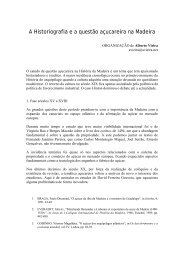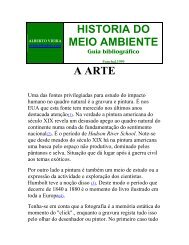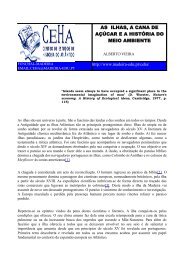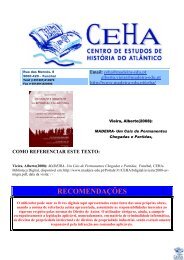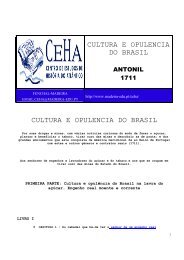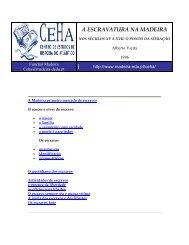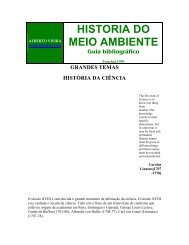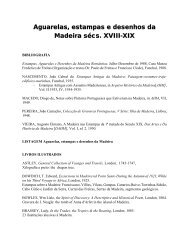SLAVERY IN MADEIRA
SLAVERY IN MADEIRA
SLAVERY IN MADEIRA
You also want an ePaper? Increase the reach of your titles
YUMPU automatically turns print PDFs into web optimized ePapers that Google loves.
practising of their Sacraments, with special relevance for Baptism and Marriage. In<br />
Funchal, in Las Palmas or Baia, the worry was the same, in spite of the different<br />
dimension assumed by slavery. In Madeira, the first recommendation this way was<br />
expressed in 1592 by bishop D. Luis Figueiredo de Lemos, when he visited the parish of<br />
Faja da Ovelha. The bishop refers the presence in the parish of many pagan slaves, that,<br />
in his understanding, should deserve the attention of the local vicars. The fact that,<br />
according to him, some of them manifested the wish of taking religious vows was an<br />
indication of the cares to be taken with the indoctrination. This way, it was recommended<br />
to the vicars and priests the attention needed in this domain, making the slaves know that<br />
"the Christian doctrine and at least the Pater Noster prayer and Ave Maria, the points of<br />
faith and the commandments of the Law of God(...)". To the parishioners were also given<br />
respectability in this sphere, ordering that the slaves more than seven years old "must be<br />
done with much diligence the teaching of the doctrine". On the other hand the vicars were<br />
advised to inform themselves about the number of slaves in the parish "and, observing<br />
that they don't know the Pater Noster and Ave Maria, the points of faith and<br />
commandments of the law of God, act against their lords, who must teach the said<br />
doctrine, and send them to church to learn at the same time they teach(...)".<br />
This insistence of the Church on the indoctrination and religious practice faced many<br />
obstacles. They could come from either the owners or the slaves themselves, that were<br />
still linked to their African rituals or Islamism. In Madeira, it was reduced the number of<br />
these defaulters towards Catholicism, just like the few denunciations testify, at the time<br />
of the Holy Office's visits to Madeira, in 1591 and 1618. The only sign might be revealed<br />
by the great number of illegitimate relationships. But here, the main cause might be the<br />
fact that the lords insisted in maintaining the female slaves free from marriage, as they<br />
use them often as concubines.<br />
The Church itself did not worry too much in following strictly the constitutions,<br />
managing equally the Baptism of the slaves born in the island through an illegitimate<br />
relationship. The only known exception happened in 1541, in the parish of Santa Cruz,<br />
where the vicar refused to baptise a child "for being the daughter of a Negro female slave<br />
captive of Antonio Correia". This is an punctual situation that shows the segregative<br />
attitude of the clergymen, as in the documentation we do not find any other similar<br />
reference. On the contrary, we noted the interest that the Church had in protecting them.<br />
In Madeira, opposed to what happened in the American continent, was not established in<br />
the parochial registers any separation between slaves and free men. The slave comes up<br />
in all of them, next to the free citizen. Even the court of the Holly Office gave them<br />
identical treatment, in processing terms, to slaves and free, in quality of defendants or<br />
victims. This valorisation of the testimony or denunciation done by the slave, that<br />
sometimes involves his own proprietor, reveals the consideration that court attributed to<br />
the slave. In Madeira, in 1618, five women and one men were referred as denouncers, all<br />
free, but ethnical origins indicated their previous condition as slaves.<br />
Another fact confirming complete religious integration of the slaves in the community is<br />
presented by the admission in convents or of collation of lesser orders. Here, just like in




